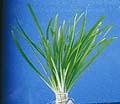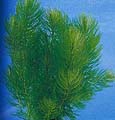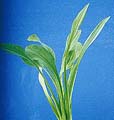 Oxygenating grasses grow submerged. They produce oxygen through the process known as photosynthesis. With the presence of sunlight, oxygenating plants absorb carbon dioxide (wastes of animal life and decaying matter) and convert it to carbohydrates needed for plant growth. At the same time, they release oxygen into the water which is essential to the balance ofthe pond. You can often see tiny bubbles of oxygen rising to the surface from these plants.
Oxygenating grasses grow submerged. They produce oxygen through the process known as photosynthesis. With the presence of sunlight, oxygenating plants absorb carbon dioxide (wastes of animal life and decaying matter) and convert it to carbohydrates needed for plant growth. At the same time, they release oxygen into the water which is essential to the balance ofthe pond. You can often see tiny bubbles of oxygen rising to the surface from these plants.
Oxygenating grasses absorb carbon dioxide which is also needed by algae and other vegetable organisms in order to thrive. A good abundance of oxygenating grasses will make it very difficult for algae to flourish by consuming most of the available carbon dioxide. In addition, the foliage serves as a bed to receive the spawn or eggs of fish and provides protection for the baby fish until they can fend for themselves.
Fish sometimes like to eat the grasses. If this should occur, make a six inch dome of one-half inch wire mesh and place over each container of grass. The grass will soon grow through the mesh and the fish can enjoy some of the grass in their diet without destroying the plant. Oxygenating grasses should be planted two bunches per container and placed in the bottom of the pond. If pond has green water when grasses are added, raise pots until grass receives sunlight. As pond clears, lower pots until pots are on bottom of pond. For ponds where fish eat the grasses, isolate the grass in a screened off area until plant matures, then spread around pond.
| Anacharis |  (Six stems per bunch) Whorls of deep green leaves attached to a single roundstem.
| | Minature Sagittaria |  (Three plants per bunch) Miniature bladed foliage. White flowers, very miniature, centered in yellow.
| | Myriophyllum |  (Four stems per bunch) Dense bushy light green foliage easily hiding containers, pond bottom, or baby fish.
| | Sagittaria Sinensis |  (Three plants per bunch) Lime green blades deeply outlined in black. White flowers lightly dotted in yellow, extend above water when planted in shallow area.
| | Vallisneria |  (Three plants per bunch) Long spiral bladed foliage sways gracefully in the water.
| |
 Oxygenating grasses grow submerged. They produce oxygen through the process known as photosynthesis. With the presence of sunlight, oxygenating plants absorb carbon dioxide (wastes of animal life and decaying matter) and convert it to carbohydrates needed for plant growth. At the same time, they release oxygen into the water which is essential to the balance ofthe pond. You can often see tiny bubbles of oxygen rising to the surface from these plants.
Oxygenating grasses grow submerged. They produce oxygen through the process known as photosynthesis. With the presence of sunlight, oxygenating plants absorb carbon dioxide (wastes of animal life and decaying matter) and convert it to carbohydrates needed for plant growth. At the same time, they release oxygen into the water which is essential to the balance ofthe pond. You can often see tiny bubbles of oxygen rising to the surface from these plants. 





